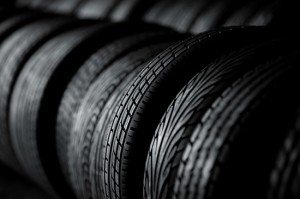You would think that four tires, purchased and installed at the same time and filled to the manufacturer’s suggested tire pressure, would wear somewhat evenly. In reality, irregular tire wear is a relatively common and frustrating occurrence that can prevent tires from performing as well as they should and compromise your safety.
Of course, tires can’t tell their owners things like, “Hey Joe, I have way too much air in me,” or “Dude, I’m in serious need of an alignment,” but they do show wear patterns that savvy drivers can use to figure out what might be going on under the chassis.
Drivers should inspect their tires regularly — at least once a week or so — and be on the lookout for the following wear issues:
Excessive wear in the center
As Pro Car Care notes, if the tires are showing too much wear right in the center of the tread, it usually means the air pressure is too high. This causes the tires to ride on the middle portion of the tread, and it will begin to wear down much faster than the rest of the tire.
Excessive wear on the edges
If the inner treads look great while the outer treads are getting too smooth, it usually indicates under inflation. If a quick check with a tire pressure gauge shows that everything is correct, this type of wear can also indicate a poor alignment or a worn out steering component. If too much of the outer treads are worn away, it is definitely time to consider purchasing new tires; Tire Buyer stocks a great selection of Continental tires and other brands at affordable prices.
Uneven wear all over
If the tires show a patchwork pattern of wear and/or flat spots here and there, it typically means that the vehicle is out of balance, notes Johnson Tire Centers. Drivers who notice this type of wear should schedule their vehicle for an alignment immediately, as simply replacing the tires will do nothing to solve the inherent balance issue.
Feathers across the treads
When a tire is feathered, it means the edge of the tread ribs have a more rounded edge on one side, while the other side of the tire is sharper. You can check for this with your hands far more easily than your eyes — just run your hand over the treads and if you feel the sharp edge on one side, feathering is probably the culprit. If one or more of the tires has a feathered appearance across the treads, notes Free ASE Study Guides, the vehicle is also overdue for an alignment. Feathering can also be caused by the toe-in setting being off; in either case, the vehicle needs to be seen by a qualified mechanic.
Scalloped tires
When the tire treads appear to be cupped or scalloped, worn out shocks or struts are usually to blame. Tires that are out of balance may also cause this problem. If the car leans too far to one side while going around a corner, this can indicate an issue with the struts, and the vehicle should be taken in as soon as possible for maintenance.
Subscribe Below
[grwebform url=”https://app.getresponse.com/view_webform.js?u=BPt&wid=73581″ css=”on” center=”on” center_margin=”200″/]

 Cody says
Cody says
February 16, 2017 at 2:13 amWhat if a tire is cupped on the inside and feathered on the outside?